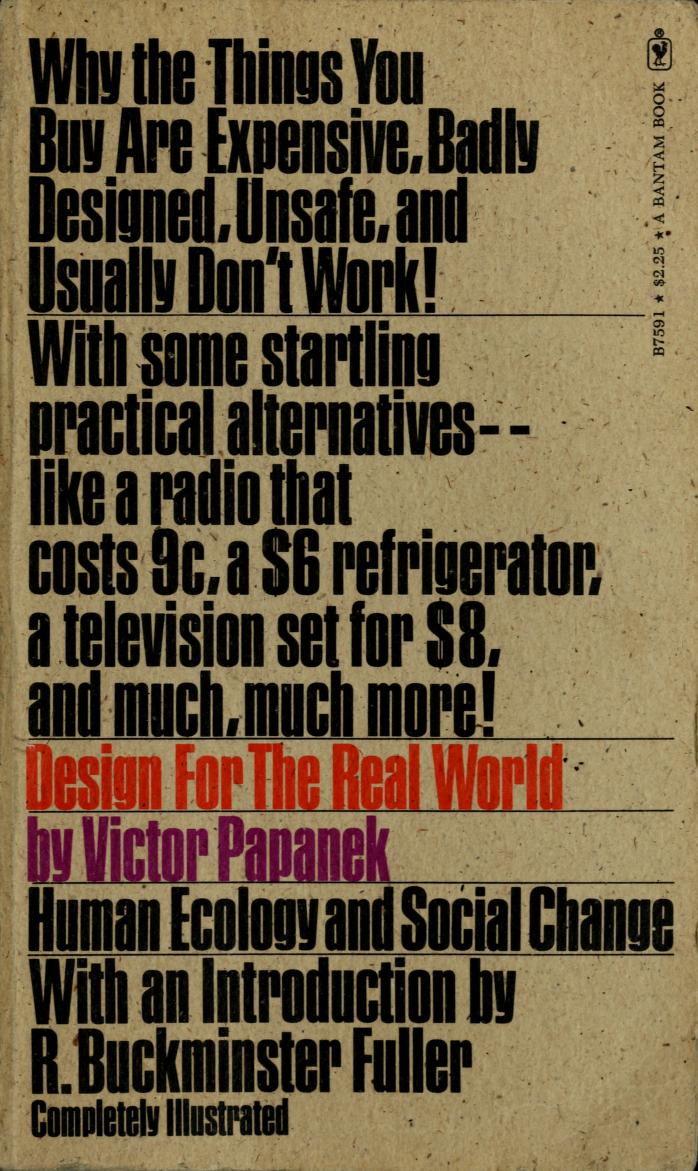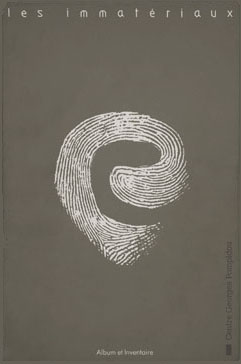Victor Papanek: Design for the Real World: Human Ecology and Social Change (1972–) [EN, CR, ES, RO, RU, DE]
Filed under book | Tags: · architecture, consumerism, design, diy, environment, ethics, industrial design, recycling

“Design for the Real World has become a classic. Translated into twenty-three languages, it is one of the world’s most widely read books on design and is a required text in many design and architectural schools. Victor Papanek examines the attempts by designers to combat the tawdry, the unsafe, the frivolous, the useless product, once again providing a blueprint for sensible, responsible design in this world which is deficient in resources and energy.”
With an Introduction by R. Buckminster Fuller
Publisher Pantheon Books, 1972
Bantam Books edition, 1973
371 pages
Reviews: Jackson (Journal of Design History, 1993), Johnson (Designophy, n.d.), Jepson (n.d.).
Commentaries: Rawsthorn (The New York Times, 2011), Hawthorne (Metropolis Magazine, 2012).
Design for the Real World (English, 1972/73, 56 MB, no OCR), 2nd edition, revised (1984, 89 MB, via Scribd)
Dizajn za stvarni svijet (Croatian, trans. Branka Đukić, 1973, 10 MB, via Mama)
Diseñar para el mundo real (Spanish, trans. Luis Cortes de Alvaro, 1977, 134 MB, no OCR, via Scribd)
Design pentru lumea reală (Romanian, trans. Florentina Badea and Cornelia Stănescu, 1997, 51 MB, via Scribd)
Дизайн для реального мира (Russian, trans. Galin Severskoy, 2004)
Design für die reale Welt (German, trans. Elisabeth Frank-Großebner, 2009, 8 MB)
See also Bisociation Tool – Victor Papanek’s “Paper Computer”, 2004.
Comment (0)Les Immatériaux: Épreuves d’écriture & Album et Inventaire (1985) [French]
Filed under catalogue | Tags: · architecture, art, cinema, code, computer art, design, industrial design, installation art, kinetic art, language, machine, painting, photography, robotics, sculpture, simulation, writing

“Les Immatériaux was a landmark exhibition co-curated in 1985 for the Centre Georges Pompidou in Paris by philosopher Jean-François Lyotard and design historian and theorist Thierry Chaput, attracting more than 200,000 visitors during the 15 weeks of its duration.
The exhibition brought together a striking variety of objects, ranging from the latest industrial robots and personal computers, to holograms, interactive sound installations, and 3D cinema, along with paintings, photographs and sculptures (the latter ranging from an Ancient Egyptian low-relief to works by Dan Graham, Joseph Kosuth and Giovanni Anselmo). The Centre de Création Industrielle (CCI) – the more ‘sociological’ entity devoted to architecture and design within the Centre Pompidou, which initiated Les Immatériaux – had been planning an exhibition on new industrial materials since at least 1982. Variously titled Création et matériaux nouveaux, Matériau et création, Matériaux nouveaux et création, and, in its last form, La Matière dans tous ses états, this exhibition, first scheduled to take place in 1984, already contained many of the innovative features that found their way into Les Immatériaux.
These features included an emphasis on language as matter, the immateriality of advanced technological materials (from textiles to plastics and holography), exhibits devoted to recent technological developments in food, architecture, music and video, and an experimental catalogue produced using computers. The earlier versions of the exhibition also involved many of the future protagonists of Les Immatériaux, such as Jean-Louis Boissier (among several other faculty members of Université Paris VIII, where Lyotard was teaching at the time) and Eve Ritscher (a London-based consultant on holography). Furthermore, Les Immatériaux benefited from projects pursued concurrently by other groups within the Pompidou which joined Lyotard’s and Chaput’s project when it was discovered that their themes overlapped. Thus, an exhibition project on music videos initiated by the Musée national d’art moderne and a project on electro-acoustic music developed by IRCAM (Institut de Recherche et de Coordination Acoustique/Musique) were incorporated into it.” (from a study by Anthony Hudek, 2009, edited)
Volume 1 contains an experimental glossary of 50 terms with contributions by twenty-six authors, writers, scientists, artists and philosophers including Nanni Balestrini, Michel Butor, François Châtelet, Jacques Derrida, Bruno Latour and Isabelle Stengers. Volume 2 reproduces the works exhibited.
Publisher Centre Georges Pompidou, Paris, March 1985
ISBN 2858502994 (I), 2858503001 (II)
263 (I) and 142 (nonpaginated A4) pages (II)
Épreuves d’écriture (Volume 1, 11 MB, added on 2014-7-30 via Norkhat)
Album et Inventaire (Volume 2, 103 MB, via Arts des nouveaux médias blog of Jean-Louis Boissier)
See also other documents and literature about the exhibition (Monoskop wiki).
Reyner Banham: Theory and Design in the First Machine Age, 2nd ed. (1960/1967)
Filed under book | Tags: · 1900s, 1910s, 1920s, aesthetics, architecture, art, art history, avant-garde, bauhaus, de stijl, design, design history, functionalism, futurism, history of architecture, industrial design, machine, technology

First published in 1960, Theory and Design in the First Machine Age has become required reading in numerous courses on the history of modern architecture and is widely regarded as one of the definitive books on the modern movement. It has influenced a generation of students and critics interested in the formation of attitudes, themes, and forms which were characteristic of artists and architects working primarily in Europe between 1900 and 1930 under the compulsion of new technological developments in the first machine age.
Publisher Praeger, New York and Washington, 1960
Second edition, 1967; Second printing, 1970
338 pages
Review (Robert Gardner-Medwin, The Town Planning Review, 1961)
Review (Dennis Young)
Review (Caroline S. Lebar, 2012)
Review (of the 2009 French edition, Hugues Fontenas, Critique d’art, 2010, in French)
Commentary (Gillian Naylor, Journal of Design History, 1997)
Commentary (Nigel Whiteley, 2005)
PDF (50 MB, no OCR)
Comment (0)
